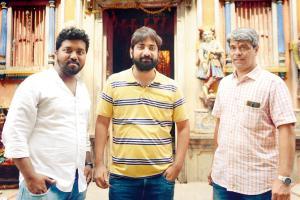While pounding the pavements of the island city, three electrical engineers from BEST turned into heritage lovers

Atul Parab, Kunal Tripathi and Nitin Nimbalkar outside a 175-year-old temple in Masjid area. Pic/Bipin Kokate
On every street of Mumbai is a small story of great entrepreneurship. On some occasions, it isn't even a street, but a sidewalk. Raghunath Narayen Khote was a mercantile expert in the 19th century. A rotund man with a regal moustache, he cast a long shadow on Bombay's public life. He was the first Indian director of an insurance company in India, the Oriental Life Assurance Co Ltd; in 1868, he was appointed the Justice of Peace; in 1883, the Sheriff of Bombay. A footpath on the western promenade of Chowpatty was named in his honour, and continues to be known as the Khote Footpath today. "This is probably the only place, where a footpath has been named after a person," says Nitin Nimbalkar, a sub-engineer with BEST since 1987.
Nimbalkar, 54, has devoted half his life to unravelling the secrets of Mumbai, to the extent that he recently finished a one-year diploma course in archaeology from Mumbai University. Like the electric cables tucked under our feet, his job and his passion for Mumbai's history are intertwined. "My first work assignment was near Crawford Market, which was the first building in Mumbai to get electricity in 1882. BEST's jurisdiction is the island city: Sion and Mahim to Nariman Point. A lot of heritage and conservation work is concentrated in this area. So, having the workplace here helped."
ADVERTISEMENT
In 2014, he started an account on Instagram and Twitter, under the handle of Deccan Odyssey, to create awareness about Mumbai's history. "People walk on these roads every day, but are not aware why they are named so. They don't know the contribution of the people who built this city. British architects like FW Stevens and [George Twigge] Molecey are known for the CST, BMC and University buildings, but natives like Sitaram Vaidya, Muncherjee Cowasji Murzban and Yashwant Harishchandra Desai were the engineers who executed them, and people don't know who they are."
Nimbalkar shares this while we are waiting for two of his colleagues. For him, small talk includes dispersing trivia on Mumbai. We are cooling our heels outside Sardar Gruha, near Crawford Market, about which he says, "Lokmanya Tilak passed away on the fourth floor of this building. Gandhi and Maulana Shaukat Ali were the pallbearers. More than one lakh people had come to pay their respects, and it took three hours to reach Chowpatty." When the mid-day photographer casually mentions he lives in Walkeshwar, he says, "Arre, you live in a heritage precinct," and deep dives into the history of Raj Bhavan and Banganga Tank. His affection is infectious, and has certainly rubbed off on his protegees.
Atul Parab, 33, and Kunal Tripathi, 34, joined BEST nearly a decade ago. Under Nimbalkar's watch, they became interested in the city's background hum as well. "Nimbalkar was my first friend in BEST," says Parab. "In his company, a certain discipline was developed to notice things about Mumbai. Now we know the name of every lane, every road in the island city." Tripathi adds, "BEST Undertaking has also helped us. We get to visit a lot of nooks and crannies because of our jobs, inspecting all the substations."
They explore the city in their free time, read up tomes on it and post bite-sized information on social media. Tripathi's Twitter handle, Mumbai Heritage, is the most popular with 383K followers. "We are a bit more underground," says Parab, who runs a blog called Monumentzman. They get most of their information from obvious sources such as the internet, gazetteers and books. "All the information is available," says Parab. "It isn't like we've unearthed it from under some rock. There's an interesting Marathi book by Govind Madagavkar called Mumbaiche Varnan. It was written in the late 19th century, and reads like a time machine. When we visit Mazgaon, Tadwadi, Matharpacady, we feel like the book is showing us the city in virtual reality. If you refer Sharada Dwivedi's book, Bombay: The Cities Within, you will come to know many things about the city. But, social media provides a platform to reach everyone." Tripathi says, "We were among the first to disperse information on Mumbai's heritage on social media. We do participate in walking tours, but organising one is not our cup of tea as of now."
We embark on an informal walk of some of the unknown landmarks of Masjid area. With the speed and gait of loiterers, they show us the temple where Jyotirao Phule was bestowed the title of Mahatma; Mumbai's oldest synagogue, The Gate of Mercy, built in 1796; and the Jama Masjid, which is so old that its renovation took place 130 years ago. We also come across an elaborately carved temple, about which the trio comes up blank. In a trice, Nimbalkar removes his footwear and interrogates the mahant; Tripathi whips out his phone and takes a picture; and Parab says, "Abhi yeh post aayega."
Catch up on all the latest Mumbai news, crime news, current affairs, and also a complete guide on Mumbai from food to things to do and events across the city here. Also download the new mid-day Android and iOS apps to get latest updates
 Subscribe today by clicking the link and stay updated with the latest news!" Click here!
Subscribe today by clicking the link and stay updated with the latest news!" Click here!







